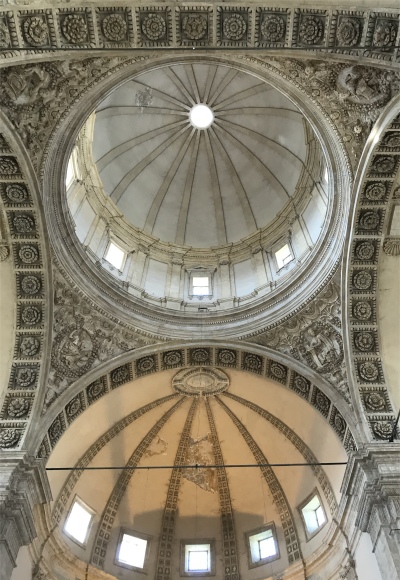Suitably cultured out by the magnificent church that overlooked the plains outside, dotted with isolated hamlets, olive groves, sunflower fields and rolling farmland, we parked up in one of the free car parks, and hiked up precipitous narrow streets, so narrow that when cars crawled down them, pedestrians had to cling to the walls of the buildings. We climbed ever upward. Todi is perched on a tall two-crested hill overlooking the east bank of the river Tiber, commanding distant views in every direction. It is encircled by three sets of concentric walls, each from a different historical era: the innermost are Etruscan in origin, the middle ones date from the town's Roman period, and the outer medieval walls survive from Todi's heyday as a prosperous centre in the Middle Ages. The walls were mainly of soft, beige/grey stone, giving way every few metres to more tumbling streets, narrow, steep, stepped alleys, many being bridged at multi-levels, all stuck in the Middle Ages.
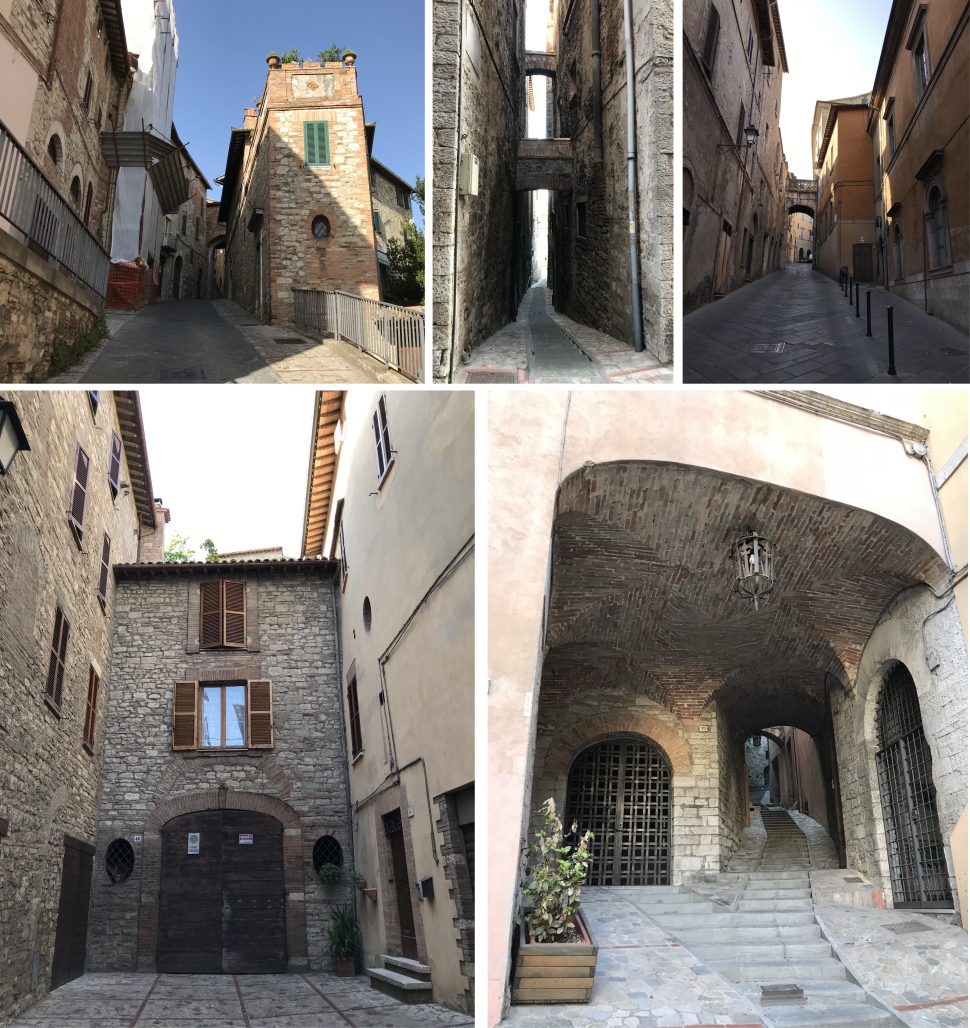
Steep Climb up into Todi
|
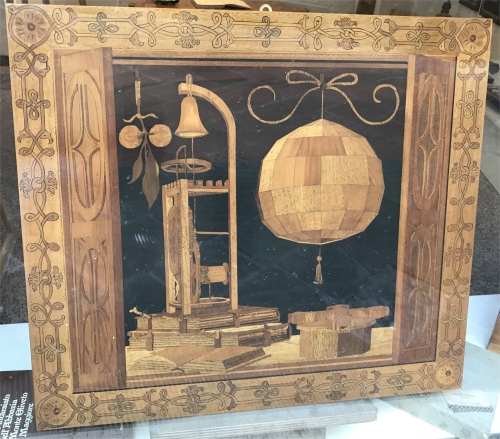
Exquisite Marquetry
|
As we climbed steadily, we came across more and more small, artisan shops and galleries dotted among the streets, selling a broad range of arts and crafts. Craftsmanship in Umbria has preserved the tradition and the ancient techniques of production. The origins go back to Medieval times and Renaissance when the so-called
arti minori reach their greatest heights. The ceramics from Deruta, Gubbio and Gualdo Tadino; the wrought iron in CittÓ della Pieve, Cascia, Magione and Montone; the art of inlay decoration in Todi; the woven fabric in Perugia and Montefalco; the lace in Orvieto and the embroidery in Assisi and CittÓ di Castello, are the most famous and iconic Umbrian crafts. They were up-market, and many grabbed my attention, one in particular that sold marquetry versions of Escher's drawings (quite appropriate when I considered that the ups and downs of these narrow streets and alleyways resembled a game of snakes and ladders). But this is a much visited historic town on the tourist trail, and prices were accordingly inflated so as to lighten the load inside the wallets of those who had dared climb up its streets. I could have spent days just exploring around these streets.

Giuseppe Garibaldi
|
The whole town oozed history. It was first inhabited by Umbrian tribes, and later by the Etruscans. It is certain that several centuries before Christ, the original settlement was on a border between the Etruscans and Ancient Umbri people. Later, Rome used Todi (then called "Tuder") as an ally and outpost against both, and granted its people Roman citizenship. In the 3rd century B.C. the Romans conquered Umbria and since the 4th century Christianity spread all over the region: the new doctrine arrived in Todi with S.Terenziano, first bishop of the town and martyr under the Emperor Adrian. Another important figure was the bishop Fortunato, who led the citizenry in the struggle against the Goths.

Palazzo del Capitano to the Left, and Palazzo del Popolo to the Right
|
In the Middle Ages Todi assumed the features of a medieval castle and it was ruled by feudal barons such as the Arnolfi, the Montemarte, the Atti. After 1000 A.D. the town expanded: commerce and handicraft return to flourish, the heads of the arts and craft associations - the Priors - began to be very important, and Todi was a free commune since the first years of the 12th century. In 1236 Jacopo dei Benedetti, called Jacopone, was born in the town, one of the most important figures of Franciscanism. Later Todi belonged to various dominions, and after this period the town was placed directly under the central power of the Papal State, which finished in 1860, with the Unification of Italy.

Palazzo dei Priori
|
Bubbling up through this rich history, we surfaced onto the top of the hill which is surprisingly flat. We tarried for a while on the Piazza Garibaldi, which takes its name from the statue erected in honour of this historical character. In July 1849, Todi received Giuseppe Garibaldi, who was fleeing after the failed democratic attempt of the Republic of Rome. The piazza afforded an unexpected sight of the underlying countryside.
Then, just around the corner was one of the most beautiful squares in Italy, the Piazza del Popolo, opening up at the highest point of Todi, the top of Nidoli hill (398 m above sea level). The Piazza del Popolo, or people's square, is a large central square built above Roman cisterns, a monumental system built in the 1st century BC, and are over 80m long. The cisterns were part of a rainwater storage and drainage system that carried water from the Forum - as now, the main square overhead - to the valley below. They also served to support the Forum, the public square of the ancient town of Tuder, which was even larger than the medieval and current square.
Standing in the square, where a wedding ceremony was taking place, I was awestruck by the buildings around me. This was the real heart of the city, where the most important buildings of secular and religious power stood: the Palazzo del Popolo (or del PodestÓ), the Palazzo del Capitano and the Palazzo dei Priori, built between the 13th and 14th centuries, and, at the other end, the Cathedral of Maria Santissima Annunziata, documented from the 12th century and altered several times in later periods.
The Palazzo del Popolo, "People's Palace", is a Lombard-Gothic construction already existing in 1213, and is one of the most ancient communal palaces in Italy. It comprises two great halls: the "Sala Grande Inferiore", or "Sala delle Pietre", and the "Sala Grande Superiore", housing the city's Art Gallery. It is one of Italy's oldest public buildings but was restored in the 19th-20th centuries.

Piazza del Popolo
|
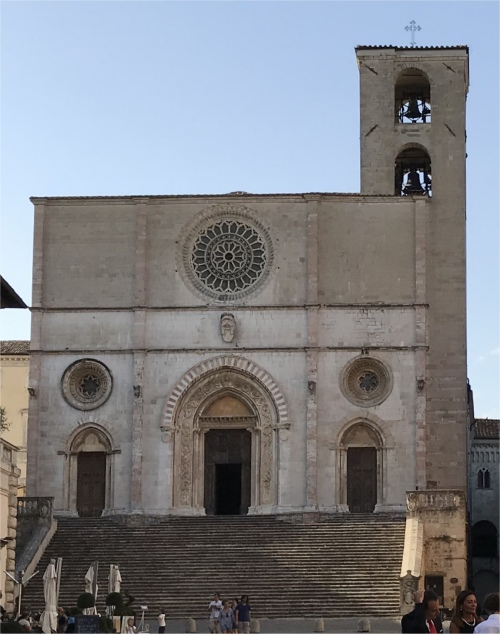
Cathedral of Maria Santissima Annunziata
|
The Palazzo dei Priori, "Priors' Palace", is located in the southern side of the Piazza, facing the Cathedral. It was begun in 1293 and later enlarged as seat of the podestÓ, priors and the Papal governors. The trapezoidal tower was originally lower, and had Guelph merlons. The fašade includes a big bronze eagle by Giovanni di Giliaccio (1347).
The Palazzo del Capitano, "Captain's Palace", is in Italian Gothic style, and was built around 1293 and named "New Communal Palace" to differentiate it from the former one. It is a grand building with elaborate windows built over a portico. The Palazzo is on two distinct levels: the first floor housed the Justice Hall (currently, seat of the Communal Council), with the Judges' offices in the lower. The latter is now occupied by the City Museum, housing the Etruscan-Roman Museum and the Pinacoteca, art museum. It includes a saddle used by Anita Garibaldi, the wife of Giuseppe Garibaldi. Some rooms are frescoed with histories of the city and portraits of its most illustrious men.
The Cathedral of Maria Santissima Annunziata, is a Gothic edifice on the Lombard plan, said to be erected over an ancient Roman building, probably a temple dedicated to Apollo. The current church was almost totally rebuilt after a fire in 1190. The main feature of the squarish fašade is the central great rose window, added in 1513. Of the same period is the wooden door of the portal, by Antonio Bencivenni from Mercatello, of which only the four upper panels remain today.
We browsed around the Cathedral for a while before seeking respite from the heat in a small square near the Teatro Comunale and enjoyed a drink outside a pizzeria. This was an excellent place to people watch. Locals and many Japanese (there was a language centre opposite the theatre) streamed out of the pizzeria with boxed pizzas. A young mother stood outside the building cuddling a baby in her arms, while one of her sons chewed on pizza and the other son sucked a pair of lollies. Two old men sat, mainly in silence, watching the world go by, seemingly in bewilderment. A bus arrived, and one of the old men hobbled off to catch his transport home while the other gazed into an invisible horizon.
But time was pressing. We had no time to visit the Palazzos or any other of the many historic sites in the city which we had not yet seen. As we retraced our steps down the maze of narrow streets I soaked up the lingering fascination of its medieval atmosphere, and could understand how Todi was known by many as the most liveable city in the world for its perfect balance of natural and historical beauty.
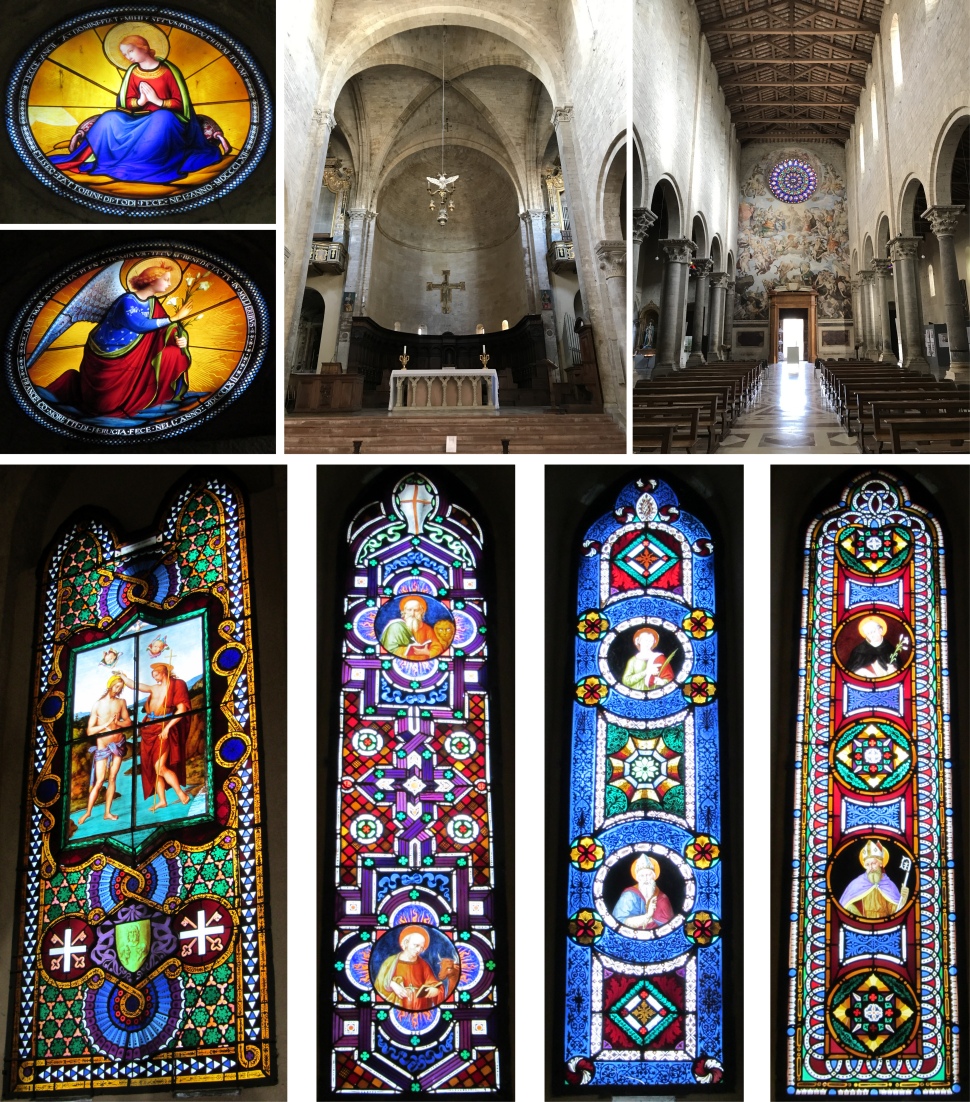
Interior of Cathedral of Maria Santissima Annunziata
|
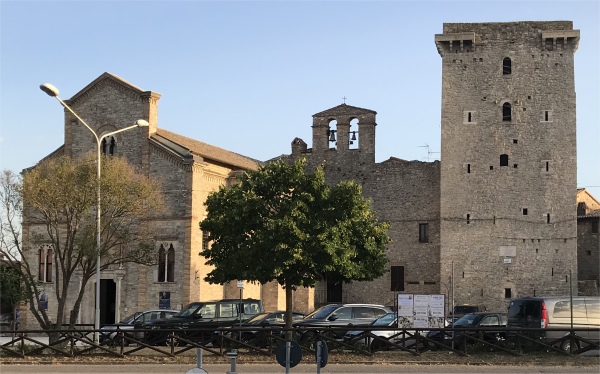
Grutti Church of S. Maria d'Agello and Castle
|
We drove across country to Grutti to attend the Gala Buffet Evening event being held there at the Villa Profidia Country House.
Gruuti lies on the so-called Petroniano Plateau, at 506 m above sea level. The name of the town derives from Grotte or Grott'ombra, terms with which it was designated in the Middle Ages and later, due to the area rich in tunnels and caves dug into the travertine mass that extends up to S. Terenziano. In the past, these were used as shelter for animals, and even as a bomb shelter during World War II . Some documents indicate that these places were used as catacombs by the first Christian faithful to seek refuge there, followers of the Tuderte bishop San Terenziano.
It is believed that the town was founded (together with San Terenziano) in the Augustan period by Roman colonists. In 1116 , the pre-existing castle with a square tower, 20m high and 8m wide, was surrounded by defensive walls and towers, by lords of the Ghibelline faction. The 13th century Church of S. Maria d'Agello is built in Romanesque style. It was built on the remains of an ancient abbey, with a trussed roof. Inside there is a 15th century apse fresco.
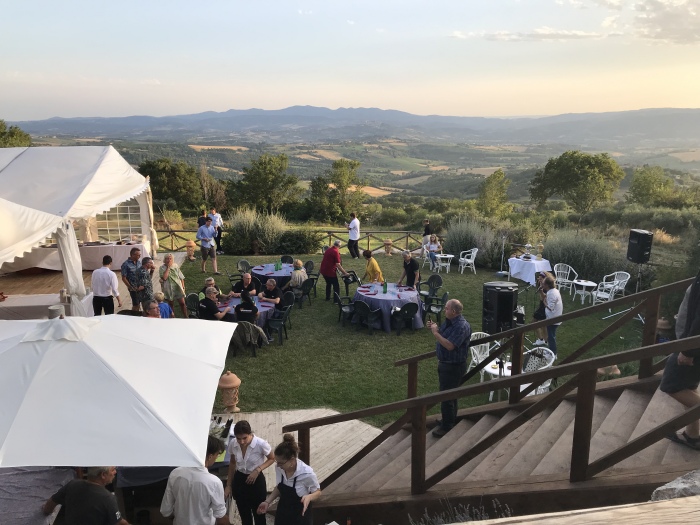
Looking out from the Petroniano Plateau
|
When we arrived, over 200 balloonists were seated around tables under a marquee overlooking a wide valley stretched out below. Spare seats were as rare as hen's teeth by the time we arrived. However, we spotted a large circular table around which the Haverill team were gathered. They kindly shifted around so that Tony and I could join them.
The wine flowed freely, the beer at a cost, and course after course of food appeared, some of which were served onto our plates, and some were placed on centralised tables where we helped ourselves. There was much harmless banter as to which nationalities would dash up to be first in line to help themselves. No comment.
The Haverill team were a marvellous bunch, a happy-go-lucky, humorous group, who treated us as one of their own.
In the background, a couple sang music all evening accompanied by a Karaoke machine. Their melodies didn't bother me, in fact to seemed to be drowned out by the din from the balloonists, but it played havoc with Tony's hearing aids.
How he managed to understand anything being said with his hearing aids playing up I don't know, but he was hogged by some South African balloonists to discuss competence testing. One of the chaps was seeking a Commercial Pilot's Licence, but Tony made it clear to them that we was not qualified to oblige them; he could only go as far as Private Pilot level.
Much fun was had by all, it was a delightful evening. Sadly it was marred by 16 balloonist vehicles having their car tyres slashed during the festivities.

